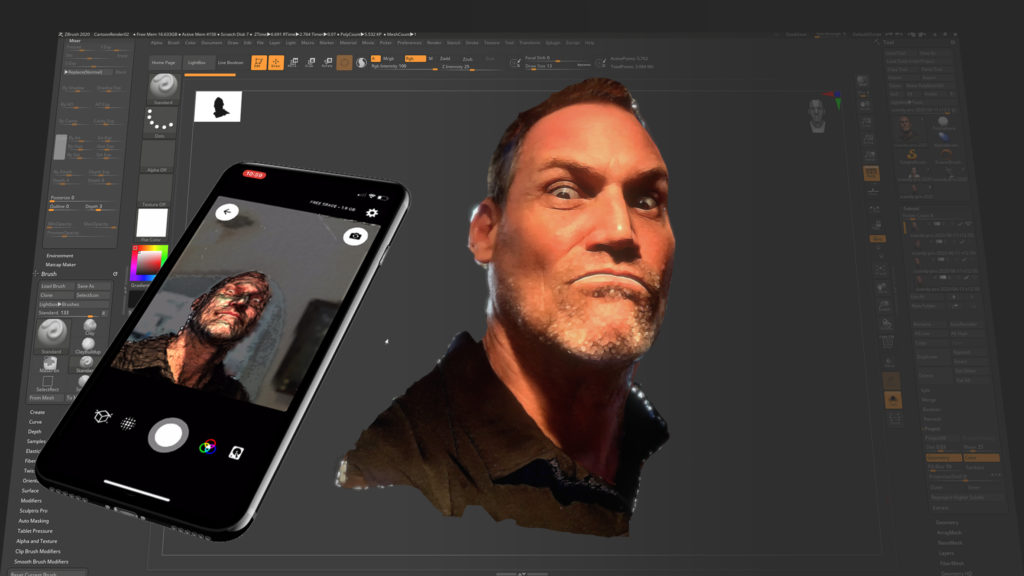The coronavirus pandemic has accelerated the development and adoption of AR tech at the consumer level. Technology that was once considered a novelty is now under serious consideration as a solution to the social distancing and quarantine measures in place to combat the spread of COVID-19.
Take eBags, for example, one of the web’s largest retailers of backpacks, luggage, and travel accessories. In 2019, the company began piloting a program to allow users to see the exact size and dimensions of a product using AR. The upshot: eBags noted a 112% increase in mobile conversions, and an 82% increase on desktop when users engage with 3D and AR assets.
The technology is there. An iPhone 11 is powerful enough to not only handle AR applications, but to also scan items to create 3D files easier than before, allowing consumers to create their own 3D scans for viewing in AR environments. This type of content has now caught up to the technology driving AR, unleashing a wider array of potential for companies across the world.

The future of AR
AR’s wider adoption will follow a path the 3D printing industry underwent throughout the 2010s. What was once novel is now being adapted for use in ecommerce, as well as in essential industries like healthcare. The ability to use an AR headset to display a patient’s vital signs, health information, and even next steps for care helps medical professionals in myriad ways.
These industry specific use cases are top-down in the sense that companies develop the technology alongside the latest hardware. Widespread adoption only occurs once the general public becomes more familiar with the technology. If users engage with their own favorite AR apps, they’re more likely to keep an eye out for the integration of this tech in the websites they visit and services they frequent.
That, in and of itself, is the issue: Where is the content? Google Glass brought the idea of an AR headset into the public consciousness, yet few have ever actually used the product or even seen someone wear the product on the street. The first generation of AR hardware was hampered by its unclear use cases.
This attitude is shifting. Companies have adopted AR this year not solely to offer a new way of looking at their products, but to actually continue operations in light of airport shutdowns and country-wide quarantines. For example, chipmaker ASML was able to leverage AR tech in a matter of days to keep its operations up and running despite having a dispersed team with limited access to facilities. Now, it’s time to see these sorts of projects realized with the average consumer in mind.
Using What You Have

A user-facing camera on a modern iPhone is powerful enough to scan an object and create an STL file from that scan. The utility of this technology is evident for 3D printing, as are the same scanning and viewing capabilities in hardware Apple’s upcoming AR headset. The two technologies – 3D scanning and 3D printing, respectively – work in tandem to create prototypes and analyze products.
What users need to see next are applications that work with their AR devices. The ability to scan products, view them in a heads-up display, and connect AR to physical use cases like 3D printing is essential. The companies that adapt this technology into their business will be at an advantage going forward, as they’ll be able to make a new avenue of interaction available to their customers.
Google, it seems, is planning their next step with AR. The company recently acquired AR hardware manufacturer North to make use of their “technical expertise.” This will allow the company to accelerate its hardware initiatives, helping to integrate their suite of apps and content into a faster adoption curve. Such a strategy would put AR on the path toward wider adoption across consumer markets, finally leading us to the augmented future we’ve long been expecting.
About the author:
This article has been written by Charles Carriere, Founder & President at Scandy.
Charles Carriere is a New Orleans native who attended the University of North Carolina at Chapel Hill where he was a Morehead Scholar. He received his BA in Anthropology. After teaching for a year at the Jakarta International School, he attended the Freeman School of Business at Tulane University, earning his MBA in Finance.
Charles then joined the investment firm of Johnson Rice & Company where he worked as an analyst and institutional stockbroker. He founded Scandy and Entrescan in 2014 as a “side-hustle” and left Johnson Rice in 2017 to work more closely with the companies he started.
Charles is married and has four children.
Remember, you can post AM job opportunities for free on 3D ADEPT Media or look for a job via our job board. Make sure to follow us on our social networks and subscribe to our weekly newsletter: Facebook, Twitter, LinkedIn & Instagram! If you want to be featured in the next issue of our digital magazine or if you hear a story that needs to be heard, make sure to send it to contact@3dadept.com






